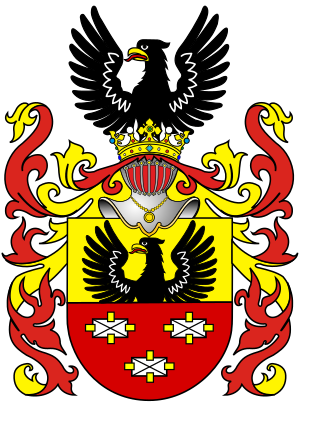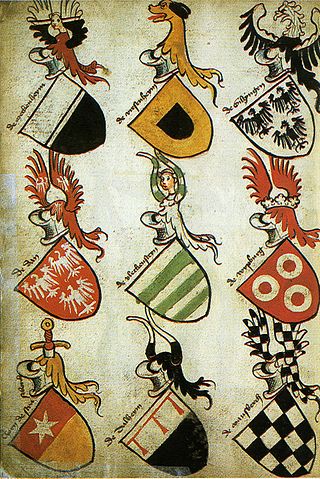
A coat of arms is a heraldic visual design on an escutcheon, surcoat, or tabard. The coat of arms on an escutcheon forms the central element of the full heraldic achievement, which in its whole consists of a shield, supporters, a crest, and a motto. A coat of arms is traditionally unique to the armiger. The term "coat of arms" itself, describing in modern times just the heraldic design, originates from the description of the entire medieval chainmail "surcoat" garment used in combat or preparation for the latter.

The Mussorgsky family, the name of an old Russian noble family, which is one of the branches of rich boyar family of Monastyryov, descendants of princes of Smolensk from Rurikid stock. The family traces its name to Roman Vasilyevich Monastyrev, nicknamed Mussorga. Peter Ivanovich Mussorgsky governed Staritsa in 1620. One representative of this family is the composer Modest Petrovich Mussorgsky.

The coat of arms of Brazil was created on 19 November 1889, four days after Brazil became a republic. It consists of the central emblem surrounded by coffee and tobacco branches, which were important crops in Brazil at that time. In the round shield in the center, the Southern Cross can be seen. The ring of 27 stars around it represents Brazil's 26 states and the Federal District.

Nikolay Mikhailovich Karamzin was a Russian historian, romantic writer, poet and critic. He is best remembered for his fundamental History of the Russian State, a 12-volume national history.

The coat of arms of the Republic of Serbia consists of two main heraldic symbols which represent the identity of the Serbian state and Serbian people across the centuries: the Serbian eagle and the Serbian cross. The coat of arms also features the Serbian historical crown; while unusual for republics, it is not unprecedented, as can be seen in coat of arms of numerous European countries with republican form of government. However, Serbia's coat of arms still retains strong monarchist elements absent from the other republics, including the mantle and pavillon found in the greater coat of arms of some modern and many historical monarchies.

The coat of arms of Germany displays a black eagle with a red beak, a red tongue and red feet on a golden field, which is blazoned: Or, an eagle displayed sable beaked langued and membered gules. This is the Bundesadler, formerly known as Reichsadler. It is one of the oldest coats of arms in the world, and today the oldest national symbol used in Europe.

The Serbian cross, also known as the Firesteels, is one of national symbols of Serbia. It is present on the coat of arms and flag of Serbia. The cross is based on a tetragrammic cross emblem of the Palaiologos dynasty of the Byzantine Empire, with the difference in Serbian use being that the cross is usually white on a red background, rather than gold on a red background. Seebian cross was adopted from Roman empire eagle and Byzantine cross which represents east Roman empire in middle-age before Ottoman occupation.

Sulima is a Polish coat of arms. It was used by several szlachta families in the Kingdom of Poland and the Polish–Lithuanian Commonwealth. Notable people using the symbol were Zawisza Czarny—a famous Polish knight—and the Sułkowski family.

The coat of arms of Russia derives from the earlier coat of arms of the Russian Empire. Though modified more than once since the reign of Ivan III (1462–1505), the current coat of arms is directly derived from its medieval original, with the double-headed eagle having Byzantine and earlier antecedents. The general tincture corresponds to the fifteenth-century standard.

The double-headed eagle is an iconographic symbol originating in the Bronze Age. A heraldic charge, it is used with the concept of an empire. Most modern uses of the emblem are directly or indirectly associated with its use by the late Byzantine Empire, originally a dynastic emblem of the Palaiologoi. It was adopted during the Late Medieval to Early Modern period in the Holy Roman Empire, Albania and in Orthodox principalities, representing an augmentation of the (single-headed) eagle or Aquila associated with the Roman Empire. In a few places, among them the Holy Roman Empire and Russia, the motif was further augmented to create the less prominent triple-headed eagle.

A roll of arms is a collection of coats of arms, usually consisting of rows of painted pictures of shields, each shield accompanied by the name of the person bearing the arms.

Denis Ivanovich Fonvizin was a playwright and writer of the Russian Enlightenment, one of the founders of literary comedy in Russia. His main works are two satirical comedies—including Young ignoramus, which mocks contemporary Russian gentry—and are still staged today.

The Reichsadler is the heraldic eagle, derived from the Roman eagle standard, used by the Holy Roman Emperors, later by the Emperors of Austria and in modern coat of arms of Austria and Germany.

Russian heraldry involves the study and use of coats of arms and other heraldic insignia in the country of Russia. Compare the socialist heraldry of the Soviet period of Russian history (1917–1991).
A national coat of arms is a symbol which denotes an independent state in the form of a heraldic achievement. While a national flag is usually used by the population at large and is flown outside and on ships, a national coat of arms is normally considered a symbol of the government or the head of state personally and tends to be used in print, on armorial ware, and as a wall decoration in official buildings. The royal arms of a monarchy, which may be identical to the national arms, are sometimes described as arms of dominion or arms of sovereignty.

Albanian heraldry is the use of heraldic symbols in Albania. The earliest form of Albanian heraldry is from the late 12th century, with the creation of the first Albanian medieval state, the Principality of Arbanon in 1190. During the 13th to the 15th century, a great number of medieval Albanian noble families had at their coat of arms the symbol of eagle like the Kastrioti, Muzaka, Arianiti, Dukagjini, but the most prominent being the Kastrioti's coat of arms, having a black double headed eagle, which became a national symbol of the Albanians during Skanderbeg's reign in the 15th century, as well as the official national flag of Albania from 1912.

The Koskullfamily, also written as Koschkull, is a wealthy aristocratic family of Livonian and German origin, famous for their extensive lands and manors. The family is descended from the first King of Livonia and officially established in Livonia as Koskele in 1302. The family spread to Estonia, Courland and Poland in the 15th century, Sweden and Finland in the 17th century, and Prussia and Russia in the 18th century. Several branches of the family still exist today. The Koskulls are believed to be related to the von der Pahlen family.

Heraldry is the system of visual identification of rank and pedigree which developed in the European High Middle Ages, closely associated with the courtly culture of chivalry, Latin Christianity, the Crusades, feudal aristocracy, and monarchy of the time. Heraldic tradition fully developed in the 13th century, and it flourished and developed further during the Late Middle Ages and the Early Modern period. Originally limited to nobility, heraldry is adopted by wealthy commoners in the Late Middle Ages. Specific traditions of Ecclesiastical heraldry also develop in the late medieval period. Coats of arms of noble families, often after their extinction, becomes attached to the territories they used to own, giving rise to municipal coats of arms by the 16th century.

The Poltoratsky family was a Russian noble family, descended from the Cossack Mark Fedorovich Poltoratsky (1729–1795), who during the reign of Catherine the Great, was in charge of the Court Singing Chapel. The Poltoratsky coat of arms shows a harp as a sign of this.

The Teglev family is an old Russian noble family which can trace its line back to 15th century.



















